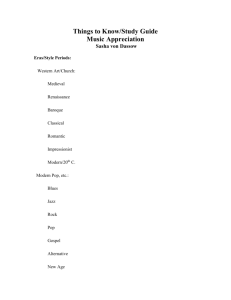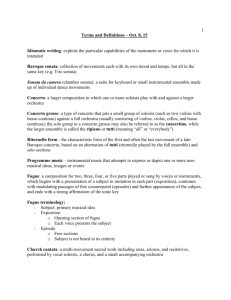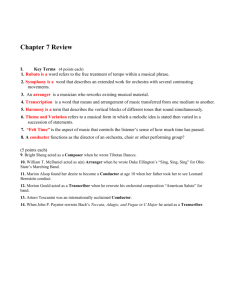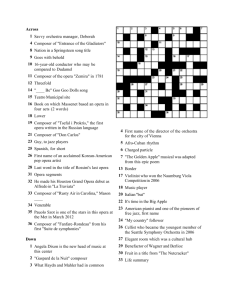Music 100 - WordPress.com
advertisement
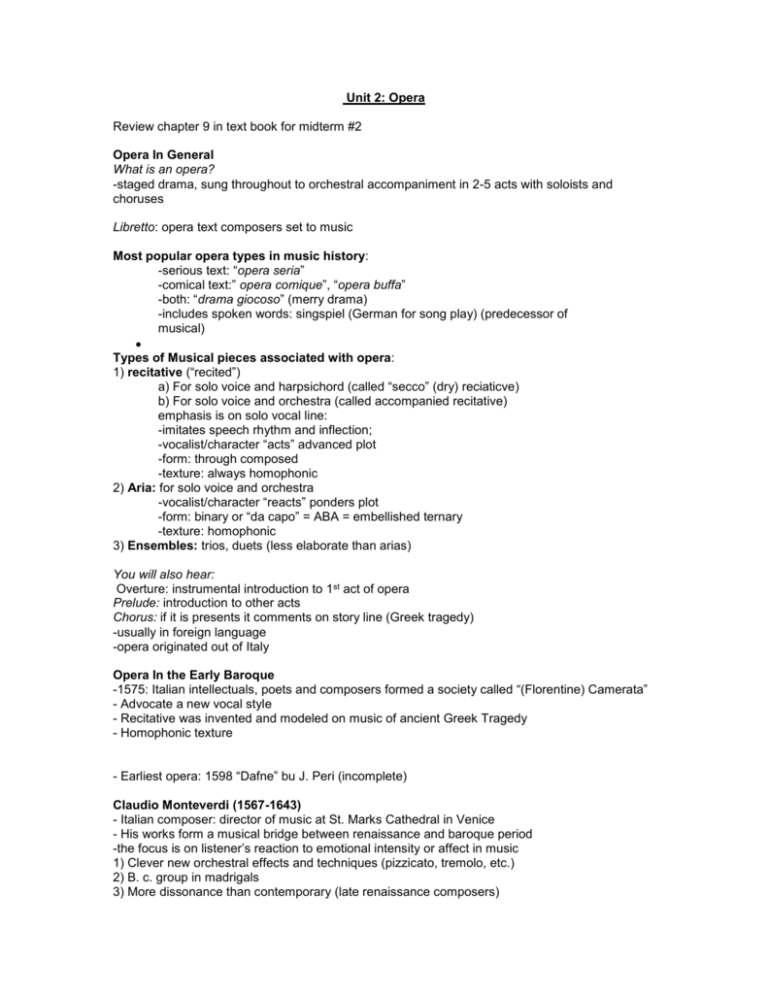
Unit 2: Opera Review chapter 9 in text book for midterm #2 Opera In General What is an opera? -staged drama, sung throughout to orchestral accompaniment in 2-5 acts with soloists and choruses Libretto: opera text composers set to music Most popular opera types in music history: -serious text: “opera seria” -comical text:” opera comique”, “opera buffa” -both: “drama giocoso” (merry drama) -includes spoken words: singspiel (German for song play) (predecessor of musical) Types of Musical pieces associated with opera: 1) recitative (“recited”) a) For solo voice and harpsichord (called “secco” (dry) reciaticve) b) For solo voice and orchestra (called accompanied recitative) emphasis is on solo vocal line: -imitates speech rhythm and inflection; -vocalist/character “acts” advanced plot -form: through composed -texture: always homophonic 2) Aria: for solo voice and orchestra -vocalist/character “reacts” ponders plot -form: binary or “da capo” = ABA = embellished ternary -texture: homophonic 3) Ensembles: trios, duets (less elaborate than arias) You will also hear: Overture: instrumental introduction to 1st act of opera Prelude: introduction to other acts Chorus: if it is presents it comments on story line (Greek tragedy) -usually in foreign language -opera originated out of Italy Opera In the Early Baroque -1575: Italian intellectuals, poets and composers formed a society called “(Florentine) Camerata” - Advocate a new vocal style - Recitative was invented and modeled on music of ancient Greek Tragedy - Homophonic texture - Earliest opera: 1598 “Dafne” bu J. Peri (incomplete) Claudio Monteverdi (1567-1643) - Italian composer: director of music at St. Marks Cathedral in Venice - His works form a musical bridge between renaissance and baroque period -the focus is on listener’s reaction to emotional intensity or affect in music 1) Clever new orchestral effects and techniques (pizzicato, tremolo, etc.) 2) B. c. group in madrigals 3) More dissonance than contemporary (late renaissance composers) L’ Orfeo 1607, by Monteverdi -most important opera of early baroque ear -includes arias, recitatives, choruses and instrumental introductions, interludes -“L’ Orfeo” features solo vocalists, chorus dancers and 40 players -B.c. group: aural emphasis shifts toward bass Story Line Orpheus (supremely gifted musician of Greek myth) is trying to bring his late wife, Eurydice back from the dead. (Listening guide, text pg. 122) “Tu Se’ Morta” (“You Are Dead”) Note: parts sound like aria, but it is “secco recitative” (from act II, CD 2 tr. 9) Scene: O. has just learnt that Eurdydice has died -vocal line is accompanied by B.c. (organ and lute) -texture: homophonic -rhythm: free, little sense of beat, irregular phrases -Passionate Speech: concept devised by Monteverdi -Word Painting: -star, sun; sung in higher notes -abysses, death; low notes 1700 Opeara was born in Italy Libreto, text of the opera New coal style, recitiative (emphasis on last syllable) -secoo and accompanied The Middle Baroque Henry Purcell (1659-1695) -most important British composed of the C17 -composer to the kings string orchestra -Organist -buried at Westminister Abbey and the Chapel Royal -he contributed to many genres: -church music, opera, instrumentals and songs Ground Bass or Basso Ostinato (obstinate bass) **Definition- a musical idea or motive in the bass line, it is repeated multiple times within the piece, melody unfolds on top, length varies ca. 4 notes to 8 measures. Ex) Pachelbels cannon- bass part Dido and Aeneas (premiered no later than July 1688) -School Production: for (mostly female) vocalists, strings, B.c. and chorus -Genre: “opera seria” - Librette inspires by work of roman poet Virgil Main Characters 1) Dido, queen of Carthage 2) Aeneas, king of the defeated Trojans Story Line: Dido falls in love with Aeneas when he lands in C. after Trojan War. Sorcerers/witches who had dido remind Aeneas that he must leave her to found the Roman Empire. He eventually leavers Dido and she commits suicide at the end of the opera. Dido’s Lament (most famous piece from this opera) -final number, consisits of 2 parts: 1) Secco recitative 2) Aria Textbook: pg 124; CD 2/tr 10-11 1) recitatice, tr. 10: “thy hand, Belinda” (sister maid); accompanied only by B.c. no strings. -music sets sorrowful mood -most famous piece from the opera 2) Aria, CD2, tr. 11 -“When I am Laid in Earth” Musical Characteristics of Aria: -opens with chromatic ground bass, stated 11x, has resemblance of a chromatic scale. Purcell uses word painting. -descending bass line signifies descent to the grave. Baroque Sonata Trio Sonata- at least 4 musicians, despite the title trio it includes the “basso continuo group” “Il Prete Rosso (The Red Priest)” -Antonio Vivaldi (1678-1741) -Italian composer, priest/musician -he was the superintendent of music at the music conservatory for orphans and female children of aristocrats in Venice. -majority of students were teenage girls -they became a major tourist attractions -output: sonatas, concertos, operas -Vivaldi became famous through publishing instrumental music -July 2012: Lost Opera Score by V found in archive in Turin Italy, among his personal papers (wrote nearly 100 operas) Best Known Work: “The 4 Seasons” 1) Depicts sounds and events associated with one season 2) prefaced by a sonenr (poen) describing each season 3)texts possibly by Vivaldi (txt 128) -set of 4 solo concertos for solo violin, string orchestra and B.c. -from Vivaldi’s op. 8 (eighth published set of musical works) -dedicated to the best orchestra in Europe (in Prague), 1725 Concerto #1 “spring” (la primaver, CD 2 tr 12-20:3) (fast-slow-fast) -forms of first and third movements 1&3 -ritornello (tutti & solo alternate) Movement 1,( tr 12,16) -5 sections with musical imagery 1) Spring has come= riternello music 2) Song of the birds 3) Murmuring springs 4) Thunder and lighting 5) Song of the birds Movement 2: The Sleeping Goatherd(CD 2, tr. 17) Pastoral scene: sleeping goatherd and dog, music is peaceful Tempo: slow Texture: homophonic 1) solo violin: goatherd 2) upper stirrings: rustling of leaves 3) violas: bark like dog (percussive sound) Movement 3: The Pastoral Dance (tr. 18-20) Scene: bagpipes accompany nymphs and shepherds dancing Form: ritornello Texture: homophonic (solo violin & B.c.) Vivaldi inspired by Italian dance music, specifically the “Danza Pastorale” *Important: Vivaldi included the ritornello melody first in major and later in minor* Programme Music - Instrumental music associated with a story, poem, idea, or scene The Suite - Popular 17&18th century instrumental genre - Set of dance inspired movements for solo instruments/instrumental ensembles -preceded by “overture” (not a dance) -form of dances: binary (AABB) *dance rhythms pervaded *all* music during the Baroque period, including vocal music* **Suite consists of 4 dances 1) allemande 2) Courante 3) Sarabande (slowest) 4) Gigue (fastest) 5) expanded to include: Bouree, Minuet Tempos vary: slow to fast Meters vary: from duple meter (bouree) to triple (minuet) “Bouree” by JS Back (Cd 2, tr 21-22) -from No. 3 of 4 of his orchestral suites (late 1720’s) -meter: duple, with upbeat -tempo: lively (even though no tempo is given) -form: binary 1) Section A: full orchestra, with trumpets and timpani 2) Section B; features SSLL (short, short, long, long) -motive for strings alone -3x as long as A The Coralle and the Canata The (Lutheran) Chorale- hymn tune sung to German religious texts, melody is typically in the soprano, set mostly to syllabic text in homophonic, or homorhythmic texture. *note: church hymns today are often called “chorales” because music is “chorale-like” (homorhythmic) The Lutheran Cantata- sacred german composition for vocalists and instrumental ensemble (incl. B.c.) with arias, recitatives, duets and choruses. Often based on chorale tunes and always performed as part of Lutheran worship service. Bach’s Chorale Canata “Wachet auf” (wake up), BWV 140 BWV- fancy abbreviation for number in Thematic Catologue of works by Bach -Cantata BWV 140 based on 17C chorale tune, still sung by Lutherans tiday as “Wake, Awake”. -form: AAB (or bar form) - A: 3 phrases, B: 6 phrases - Chorale melody, used by Bach -in movements 1, 4, and 7 only Review from last class: The term "suite": dance inspired movements for solo instruments or instrument ensemble with at least 4 movements. Allemande - Courante - Sarabande - Gigue plus Bouree and Minuet 9m The chorale and the cantata The Lutheran chorale: - hymn tune sung to German religious text with melody in soprano, and set to mostly syllabic text in homophonic or homorhythmic texture. Note: Church hymns today are often called "chorales" because music is "chorale-like" homorhythmic The Lutheran cantata: -sacred German composition for vocalists and instrumental ensembles (included basso continuo) with arias, recitatives, duets and choruses. often based on chorale tunes and always performed as a part of Lutheran worship service. example of Lutheran cantata: Bach's choral cantata "Wachet auf" translates to wake up. BWV140 BWV- fancy abbreviation for number in Thematic Catalogue of works by Bach. -Cantata BWV 140 is based on C17 chorale tune, still sng by Lutherans today as "Wake, awake" -Form: AAB "bar form" -A is 3 phrases; B is 6 phases -Chorale melody used by Bach in movements 1, 4 and 7 only. -CD 2 TR 23 "Zion Hears" is 4 movements from "Wake, awake" featuring tenors, strings, and basso continuo group. -Bach combines 3 different musical strands: 1.fast, continuous melody in upper strings: refrain like 2.slower accompaniment in lower strings 3.slowest: choral melody, broken up into individual phrases, sung by tenor What texture is this: more complex than homophonis, but not as complex as polyphonic. "Multi layered texture" Note: if one of the melodies is a chorale, it's called "cantus firmus" (Latin for firm song): referring to pre- existing melody in long notes. Lets listen to it: focus on! -strings which play the melody (riternello) -basso continuo group provides the accompaniment -tenors who sing the chorale melody or cantus firmus. (translation on 140) Movement #7 "Glory be dung to you": choral tune -German texts+- begins with (Latin) word "Gloria" -Texture is homophonic, but bass more active than other parts New vocal genre: The Oratorio Performance context: concert and not church. It is a vocal composition similar to cantata and opera. It contains arias, recitatives and choruses but NO chorales. It has a plot and character but contains no acting, scenery or costumes! Plot: often based on stories for the Bible. A composer who wrote many oratorios was: G. F. Handel (1685-1759) He was a multinational composer who was born in Germany and trained in Italy (1705-1710). He moved to the UK to become the most famous 18th centurn British composer! Which was ironic because he never beame a British citizen. He was a accomplished organist, but best known for his vocal music. His early career was operas (in Italian) for castrato singers. His later work was ontorios (in English) he died in 1759. He was rich and single. Written in 3 weeks and in 1742. (Slide on Monday) Wolfgang Amadeus Mozart (1756-1791) -Born in Salzburg, Austria, into musical family - Child prodigy, toured Europe with father Leopold and (equally talented) sister Nannerl; - Violinist, keyboardist; free mason; - moved to Vienna in 1780 to become - first successful “free-lance” composer. - Contributed to virtually all musical genres: - 600+ works, chronologically numbered by cataloguer “Koechel”…? - “K.” numbers, instead of opus (op.) to reference works. - M. died young, at age 35. Mozart’s Symphony no. 40, 1788, 1st movement, CD 2, tr. 34-42 - uses Sonata form which consists of 3 main sections: 1. The Exposition Theme 1: always in home key (tonic) Here: begins with lower strings (accompaniment) Main melody in upper strings: 3-note “sigh” figure. After Theme 1: “Transition” or “Bridge”section; modulates; ends with a big cadence and rests. Theme 2, tr. 36 – complete contrast to Theme 1! In SF, Th. 2 must always be in different key and contain new material, here: MAJOR key, more lyrical (expressive) and more chromatic than Theme 1; divided between strings and WW. the closing theme, tr. 37! Stays in same key as Theme 2! Here: Mozart recalls 3-note sigh figure from beginning (“it’s a horse”) AND then writes descending scales; full orchestra! To recap: the Exposition in SF consists of which sections? - Theme 1 – in home key (tonic) - Transition – modulation - Theme 2 – new key - Closing Theme – stays in new key Section 2: The Development, tr. 39 - Composer “develops” (=manipulates) - musical elements (melody, rhythm, instruments, harmony, texture, etc.) - from Themes 1 and 2 from Exposition. - Specifically, Mozart includes 1) melodic fragments that “travel” from WW to violins; and 2) sudden dynamic changes andmodulations! 3) The Recapitulation, tr. 40-41 - slightly modified exposition: - Theme 1 returns in tonic key, - followed by the transition, which does not modulate, but brings back Theme 2 in tonic key as well. We finish with a closing section, which can be followed by Coda (like a “P.S.” in a letter)! Operas: “Don Giovanni”, 1787 - Genre: blend of comic and serious opera OR “dramma giocoso” (“jolly drama”)! - Premiered in Prague, not Vienna. - Libretto: (text in Italian) by Lorenzo da Ponte; - Story based on “Don Juan”, legendary Spanish lover: - seduction - violence - slapstick - social class issues… - [ends with:] the supernatural! The opening scene: - Masked aristocrat Don Giovanni (DG, baritone) - tries to rape lady Donna Anna (DA, soprano)! - Her father, the Commendatore (officer, bass), - challenges DG to duel, but DG kills him! - scares (otherwise funny) Leporello, DG’s servant. - DA and fiance Don Ottavio (tenor), swear revenge! - End of opera: ghost of father appears, - invites him to dinner; DG refuses is dragged to hell!!!! (Finish Mozarts Don Giovanni) The Music in the Opening Scene: 1) an orchestral introduction 2) aria in a patter style (syllabic): anxious servant Leporello keeps repeating same note (I think someone’s coming I don’t want to be discovered) 3) trio/quartet(DG/DA/faher/leporello) “fighting music” during the duel (scary) -watch it on UR Course outline Themes and Variations in the Late 18th Century -in the classical period T&V was often used by the composer as the structure (form) of either on e movement in a symphony, sonata, or string quartet or for a separate, independent piece. Review: Theme: basic musical idea that the variations are based on. They may be newly composed (original) or borrowed from somewhere else. In Theme & Variation Form -all musical elements can be varied (melody, rhythm, texture, dynamics, tempo, meter, etc) -harmony: modes (major or minor) -tone colour: composer can use different instruments in variations What Stays The Same? Length of variations! A composer who used this form was: Joseph Haydn (1732-1809) -famous Austrian composer, free mason, close friend of Mozart -long time Kapellmeister (director) of orchestra maintained by Astro-Hung. -Prince H. was a “house officer”, wore uniform ranked as high as a cook -output: sacred music, symphonies, sonatas, operas and he invented (standardized) the string quartet (SQ) -he also travelled 2x to England in1790’s to premiere his music Haydn’s “Surprise” Symphony (playing variation on exam) -no. 94 of 104 symphonies -no. 2 of 12 “London Symphonies written for concerts in British Capital Second Movement, Andante (CD 2/tr. 43-48) -in theme and variation form; -theme: folk-line melody, sounds like “twinkle twinkle little star” Opening Theme (CD 2/tr 43) -presented by strings -played staccato (dots below notes) at piano dynamics 2nd Part of Theme Violins continue -dynamic: piano -articulation: staccato -section ends with “twinkle” -then repeated with flutes and oboes added Variation (tr 44) -timpani(plays on opening beat) -strings (theme and countermelody) -woodwinds (countermelody, softly) Variation 2 (tr 45) -begins in minor; changes to major -dynamics also change: fortissimo (piano) Variation 3 (tr 46) -oboes -flutes -theme is repeated in faster notes -major key -staccato melody in violins -counter melody in flute and oboes Variation 4 (tr 47) -brass -woodwinds -theme in brass and woodwinds -syncopated fast n toes in violins The End/Closing Section (Track 48) -legato version of theme, in dotted rhythm Handel’s Oratorio “Messiah” -written in only 24 days -premiered in Dublin in, 1742 -20 singers, strings, trumpets and B.c. -unusual libretto: in 3 parts -no plot, no characters -Charles Jennens drew themes from the bible -Christmas -Easter -resurrection -musical focus is primarily on the chorus EXAMPLE “Every Valley Should Be Exhalter” Handels Messiah; Pg 144, CD 3, tr 27. -from part 1: -aria for tenor, strings, B.c. -based on a verse from the bible -aria opens and closes with orchestral ritornello music in strings -tenor solo part is imitated by orchestra MUSICAL CHARACTERISTICS -word painting -low: low note -crooked: wavy or sigh figure -exalted: mellismatic figure (“plain” many notes per syllable) EXAMPLE “Hallelujah” Chorus Pg. 146, CD 2, tr, 28-33 -Handel uses different textures to simultaneously showcase and challenge his performers -Unifying element: “hallelujah shouts” from the chorus -tr 28: homorhythmic opening, first orchestra, then chorus on hallelujah -tr 29: monophonic, “for the lord god” -tr 30: polyphonic, “for the lord god” -tr 31: homorhythmic, “the kingdom” -tr 32: polyphonic “fugal”, “and he shall reign” -tr 33: various textures, “king of kings, etc” Classical Period: Late 18thC Society and Music -influenced by the enlightenment movement -reason started to be applied to everything, the intellect reigns over religion. -change in class system (French revolution) -the middle-class emerges, and musical sponsors & patrons now commission musical works 2 types of performers common: -amateur musicians=initmate settings (at home = piano) -professional musicians=public performances (concert halls) Characteristics of Music Written During the classical Period (1770-1820) -“modern” orchestra established -no more B.c. -lower strings -WW in pairs -new instrument: clarinet -contrast of moods -more than one “affect” (emotion) per piece -change of rhythm -wealth of patterns -texture was usually homophonic -melody was predictable, symmetrical (8 bar phrases) -folk and popular 18thC pieces were made -dynamics more crescendo and decrescendo *midterm #2 will be asked to provide correct musical period for genres, musical characteristics, forms, etc. EX) you see contrast of moods you write “C” for Classical Common Musical Genres on the Classical Period include: 1) sonata: for solo instrument or with keyboard accompaniment 2) symphony: for standard orchestra (strings, WW, Br, Perc) orchestra 3) String Quartet (SQ): for strings (2 violins, viola, cello) All of these genres are in 4 movements with these: 1) tempos: fast-slow-dance (minuet, scherzo” medium fast) – Fast 2) structural design/forma) sonata form (SF), used typically in 1st and 4th movements of sonatas, syphnies, and SQ Ludwig van Beethoven (1770-1828) -Associated with 2 historical periods: - Classical and Romantic! - German composer, but based in Vienna, Austria: - played for Mozart at age 16; studied with Haydn; dazzled - Viennese audiences as a virtuoso pianist. - Nobility showered B. with $ gifts; financial independence! - Never really employed, but taught, performed, had music published. - 1802: “Heiligenstadt Testament” = suicide note, written because of increasing deafness! Able to compensate because he possessed “perfect” or “absolute pitch”! Beethoven and Rondo form -Rondo form is based on ritornello form and looks like this: -A-B-A-C-A or A-B-A-C-A-B-A, with…. -A being the main theme (refrain) and -B and C being other, contrasting themes! -B. used it, e.g., for last movement of -string quartets, including SQ op. 18, no. 4 (of 6), movement 4: “Rondo”, 1799-1800; CD 3/1-4 -Op. 18: first set of string quartets B. ever wrote! -Only piece for Midterm 2 that features 4 single strings instruments. -Overall structure: ABACABA -Tr. 1 – A = “gypsy” melody, 1st violins, staccato, minor -Tr. 2 – B = lyrical, expressive melody, legato, major -Tr. 4 – C = ascending and descending scales, major Beethoven’s Symphony no. 5, CD 3, tr. 17-24 or “Fate knocking on the door” -From 1808, op. 67, c minor, 4 movements, -SILENCE is as important as SOUND! -Form: Sonata form! The Exposition or “Beethoven’s 5th” -Theme 1, tr. 17: -Basic rhythmic motive -Short-Short-Short-Long dominates entire movement !!!! Important: 1) played “in unison” mode unclear, very mysterious! 2) motive surrounded by rests to increase tension. -But no rest for the listener: -Strings immediately repeat SSS-L motive! -Tr. 18: Transition, fortissimo! Tr. 19: Theme 2 =multiple melodies: 1) French horn call melody in major: “Beethoven’s 5th is on” – similar to SSS-L theme! 2) Lyrical melody, legato, piano; 3) Triumphant descending melody follows, ff, violins, tr. 20. Tr. 21: Exposition repeats Next: The DEVELOPMENT Tr. 22: horn call motive (Beethoven’s 5th is on) “fragmented” (broken up) in strings! Cellos and basses reply with descending scale: Echoed between WW and strings (at 3:32), then distinct dynamic contrasts lead us to the Recapitulation, but we’ll go straight to: The CODA, tr. 24: “Beethoven’s 5th is on”, SSS-LLL motive back! At 6’10”: a NEW, rising melody/theme appears in the strings! B. was first to introduce NEW themes into in any movement in Sonata form! The 19th century aka the “Romantic” period in music -C19 fine arts and literature in general emphasized these “themes”: 1. Emotional subjectivity (“it’s all about me”) 2. Imagination (fantasy, supernatural) 3. Individuality (freedom of expression) 4. Nature (inspired visual artists, authors) 5. Middle Ages (“gothic” revival; castles, knights) 6. The “Wanderer” motive = true happiness only achieved through death! -Romantic period: louder and longer! 1) Music now more chromatic, expressive, emotionally intense! Main melodies now appear in ANY instrumental part, including the newly invented “Wagner tuba” and the saxophone! Gigantic orchestras and choruses, huge opera productions 2. Nationalism and Exoticism embraced by composers: Nationalism: use of folk songs, dances, legends, history Russia, Finland, Bohemia/Czech Republic; Exoticism = melodies, rhythms, or instruments that suggest foreign lands (Spanish guitars, Japanese flutes); 3. Programme Music increasingly popular, with new genres emerging (more on that after Midterm 2). 4. Miniature pieces (“Lied”/art song, “character piece” for piano) popular. Ludwig van Beethoven (1770-1828) -Associated with 2 historical periods: - Classical and Romantic! - German composer, but based in Vienna, Austria: - played for Mozart at age 16; studied with Haydn; dazzled - Viennese audiences as a virtuoso pianist. - Nobility showered B. with $ gifts; financial independence! - Never really employed, but taught, performed, had music published. - 1802: “Heiligenstadt Testament” = suicide note, written because of increasing deafness! Able to compensate because he possessed “perfect” or “absolute pitch”! Beethoven and Rondo form -Rondo form is based on ritornello form and looks like this: -A-B-A-C-A or A-B-A-C-A-B-A, with…. -A being the main theme (refrain) and -B and C being other, contrasting themes! -B. used it, e.g., for last movement of -string quartets, including SQ op. 18, no. 4 (of 6), movement 4: “Rondo”, 1799-1800; CD 3/1-4 -Op. 18: first set of string quartets B. ever wrote! -Only piece for Midterm 2 that features 4 single strings instruments. -Overall structure: ABACABA -Tr. 1 – A = “gypsy” melody, 1st violins, staccato, minor -Tr. 2 – B = lyrical, expressive melody, legato, major -Tr. 4 – C = ascending and descending scales, major Beethoven’s Symphony no. 5, CD 3, tr. 17-24 or “Fate knocking on the door” -From 1808, op. 67, c minor, 4 movements, -SILENCE is as important as SOUND! -Form: Sonata form! The Exposition or “Beethoven’s 5th” -Theme 1, tr. 17: -Basic rhythmic motive -Short-Short-Short-Long dominates entire movement !!!! Important: 1) played “in unison” (monophonic texture) mode unclear, very mysterious! 2) motive surrounded by rests to increase tension. -But no rest for the listener: -Strings immediately repeat SSS-L motive! -Tr. 18: Transition, fortissimo! Tr. 19: Theme 2 =multiple melodies: 1) French horn call melody in major: “Beethoven’s 5th is on” – similar to SSS-L theme! 2) Lyrical melody, legato, piano; 3) Triumphant descending melody follows, ff, violins, tr. 20. Tr. 21: Exposition repeats Next: The DEVELOPMENT Tr. 22: horn call motive (Beethoven’s 5th is on) “fragmented” (broken up) in strings! Cellos and basses reply with descending scale: Echoed between WW and strings (at 3:32), then distinct dynamic contrasts lead us to the Recapitulation, but we’ll go straight to: The CODA, tr. 24: “Beethoven’s 5th is on”, SSS-LLL motive back! At 6’10”: a NEW, rising melody/theme appears in the strings! B. was first to introduce NEW themes into in any movement in Sonata form! The 19th century aka the “Romantic” period in music -C19 fine arts and literature in general emphasized these “themes”: 1. Emotional subjectivity (“it’s all about me”) 2. Imagination (fantasy, supernatural) 3. Individuality (freedom of expression) 4. Nature (inspired visual artists, authors) 5. Middle Ages (“gothic” revival; castles, knights) 6. The “Wanderer” motive = true happiness only achieved through death! -Romantic period: louder and longer! 1) Music now more chromatic, expressive, emotionally intense! Main melodies now appear in ANY instrumental part, including the newly invented “Wagner tuba” and the saxophone! Gigantic orchestras and choruses, huge opera productions 2. Nationalism and Exoticism embraced by composers: Nationalism: use of folk songs, dances, legends, history Russia, Finland, Bohemia/Czech Republic; Exoticism = melodies, rhythms, or instruments that suggest foreign lands (Spanish guitars, Japanese flutes); 3. Programme Music increasingly popular, with new genres emerging 4. Miniature pieces (“Lied”/art song, “character piece” for piano) popular. Hints: -Lied: not on midterm -no need to define any characteristic of romantic period, just identify them correctly 2 examples 1) Composer 2) Title, movement, variation, larger work 3) Genre 4) Form 5) Texture -provide only title of a movement if there is one -with bethoveen, classical/romantic -sometimes the title of the piece is also the genre -use overall texture -only two will start in the middle of the piece -variation Haydn Surprise Symphony- must give correct number of the variation -other one will be from a symphony, other composer profile -6 of the listening examples 3 of them will be works discussed in class that have multiple movements associated with them Definitons do 3 out of 7 -some difintions will focus on two related genres such as -chorale, canata -opera, oratorio -arias and recitatives (sub-types, forms) -go from general to specific! -composers names and titles of pieces Chapter 9 “the Baroque (trio sonata)” -trio sonata always involves 2 solo instruments and B.c. there are always 2 types of trio sonatas (trio sonatas are not in sonata form) -story lines of operas: highlights are fine Composer -Mozart and symphony no 40/1 -Beethoven and Symphony no 51/1 -at least one page -define the genre symphony: include sections of the orchestra involved in playing (strings, ww, brass, percussion) -tempo and types of music -1,2,4 use tempo markings (f,s,f) -3 is usually a dance either a minuet or scherzo Sonata Form: -exposition: Theme 1, home tonic key Transiton: modulates to Theme 2 in new key Closing key stays in New Key -development: manipulates themes from expositon, many keys -recapulatlaion: slightly modified recapulation, all themes in tonic key (coda) Profile: 1) how composer has conceived each theme (melody, harmony, texture, rhythm, etc.) 2) what he does in the development section 3) point out anything unusual that happens through the movement -mozarts starts with an accompaniment, more subtle Name correct period in music history: There are only 3 correct answers -Baroque= B (do not need to distinguish between early, middle, or late) -Classical= C -Romantic= R Wander Motive: ________ I will draw from: -philosophical movements -historical themes (romantic period, wanderer motive etc) -names of composers -musical characteristics -titles of pieces -mozart or back


